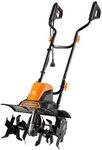Buying Guide for the Best Corded Electric Tillers
Choosing a corded electric tiller can make gardening and soil preparation much easier, especially if you want a tool that is easy to use, low-maintenance, and environmentally friendly. When picking the right tiller, it's important to think about the size of your garden, the type of soil you have, and how often you plan to use the tiller. Understanding the key specifications will help you find a model that matches your needs and makes your gardening tasks more efficient and enjoyable.Motor Power (Amps)Motor power, usually measured in amps for corded electric tillers, tells you how strong the tiller’s engine is. A higher amp rating means the tiller can handle tougher soil and dig deeper or through more compacted ground. Lower amp tillers (around 6-8 amps) are best for light-duty work, such as small flower beds or already-loose soil. Medium power (8-10 amps) is suitable for average garden beds and moderate soil conditions. High power (10+ amps) is ideal for larger gardens or breaking new ground. To pick the right one, consider the size of your garden and how hard your soil is—harder or larger areas need more power.
Tilling WidthTilling width is the width of the soil the tiller can work in one pass. Wider tillers (16 inches or more) cover more ground quickly, making them good for large, open spaces. Narrower tillers (8-12 inches) are easier to maneuver in tight spots, like between rows or in small gardens. If you have a big, open garden, a wider tiller saves time. For smaller gardens or areas with lots of plants, a narrower tiller gives you better control.
Tilling DepthTilling depth is how deep the tiller can dig into the soil. Shallow tillers (up to 5 inches) are good for mixing in compost or preparing flower beds. Medium depth (5-8 inches) works for most vegetable gardens. Deep tillers (8 inches or more) are needed if you want to break new ground or prepare soil for root vegetables. Think about what you plan to grow and how much you need to loosen the soil—deeper tilling is better for new gardens or root crops.
WeightThe weight of a tiller affects how easy it is to use and move around. Lighter tillers (under 25 pounds) are easier to handle, especially for smaller people or those with less strength, but may not dig as deeply or handle tough soil well. Heavier tillers (over 30 pounds) can dig deeper and are more stable, but may be harder to maneuver. Choose a weight that you feel comfortable lifting and pushing, based on your physical ability and the type of soil you have.
Cord Length and ManagementCorded tillers need to be plugged in, so cord length and how you manage the cord are important. Most tillers don’t come with a very long cord, so you’ll likely need an outdoor extension cord. Make sure you have a cord long enough to reach all parts of your garden. Also, look for features that help keep the cord out of the way while you work, so you don’t trip or accidentally unplug the tiller. If your garden is far from a power source, consider how you’ll manage the cord before choosing a corded model.
Number and Type of TinesTines are the blades that dig into the soil. More tines usually mean the tiller can cover more ground and dig more effectively. Some tillers have curved tines for better soil mixing, while others have straight tines for breaking up hard soil. If you need to break new ground or deal with tough soil, look for more and stronger tines. For lighter work, fewer tines are easier to control and maintain.












